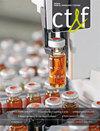利用废甘油和乙酸钠提高普通小球藻的脂质产率
IF 0.5
4区 工程技术
Q4 ENERGY & FUELS
引用次数: 27
摘要
虽然微藻作为生物柴油的原料具有很大的潜力,但必须提高生物质的生产效率和脂质生产效率。实现这一目标的一种方法是实施混合营养培养和调节碳/氮比。本研究旨在提高小球藻UTEX 1803中生物质和脂质的生产效率,以生物柴油生产的废甘油(1、5和10% v/v)和乙酸钠(5、10和20 mM)为碳源,并改变初始氮浓度(1.02;1.47和2.94mM de NaNO3)。所有实验均在23±1℃下进行,5 d内明暗周期为12:12 h。生物量产量显著增加(比未经改造的自养培养高80%)。脂质比对照最高可达2.18%。脂质产量分别是对照组的2.83倍和3.5倍。结果表明,利用生物柴油工业的废甘油作为碳源,应用碳/氮比可以增加生物质和脂类的产量,这为这种残留物的再利用开辟了巨大的可能性,从而提高了整个过程的可持续性。也证明了使用乙酸钠的碳氮比是一个有趣的替代方案,因为使用乙酸钠的低成本碳氮比是一个有趣的替代方案。本文章由计算机程序翻译,如有差异,请以英文原文为准。
Improvement of lipid productivity on chlorella vulgaris using waste glycerol and sodium acetate
Although microalgae have great potential as a raw material for biodiesel production it is necessary to increase both biomass and lipids productivity. One way to achieve this goal is the implementation of mixotrophic cultures and the regulation of carbon/nitrogen ratio. The present work aims to improve the productivity of biomass and lipids in Chlorella vulgaris UTEX 1803 using waste glycerol from biodiesel production (1, 5 and 10% v/v) and sodium acetate (5, 10 and 20 mM) as carbon sources together with modification of the initial concentration of nitrogen (1.02; 1.47 and 2.94mM de NaNO3). All experiments were performed at 23±1ºC, with light: dark cycles of 12:12 h during 5 days.
In biomass production was achieved a significant increase (80% higher that autothrophic cultures without modification). The best percentages of lipids exceeded control culture up to 2.18. Lipid productivities were also found 2.83 and 3.5 times greater than control.
Results show the possibility of increasing the production of biomass and lipids by applying the carbon/nitrogen ratio using as a carbon source waste glycerol of the biodiesel industry that opens up great possibilities for the re-use of this residue thus increasing the sustainability of the process in general, Also has been proved that carbon/nitrogen ratio using sodium acetate is an interesting alternative due to his low cost carbon/nitrogen ratio using sodium acetate is an interesting alternative.
求助全文
通过发布文献求助,成功后即可免费获取论文全文。
去求助
来源期刊

Ct&f-Ciencia Tecnologia Y Futuro
Energy-General Energy
CiteScore
1.50
自引率
0.00%
发文量
7
审稿时长
>12 weeks
期刊介绍:
The objective of CT&F is to publish the achievements of scientific research and technological developments of Ecopetrol S.A. and the research of other institutions in the field of oil, gas and alternative energy sources.
CT&F welcomes original, novel and high-impact contributions from all the fields in the oil and gas industry like: Acquisition and Exploration technologies, Basins characterization and modeling, Petroleum geology, Reservoir modeling, Enhanced Oil Recovery Technologies, Unconventional resources, Petroleum refining, Petrochemistry, Upgrading technologies, Technologies for fuels quality, Process modeling, and optimization, Supply chain optimization, Biofuels, Renewable energies.
 求助内容:
求助内容: 应助结果提醒方式:
应助结果提醒方式:


